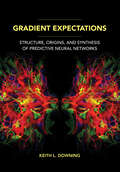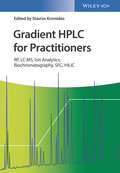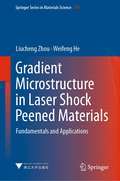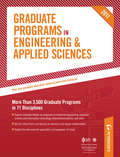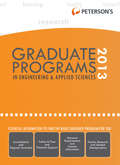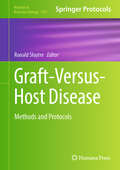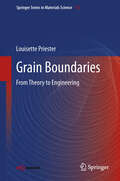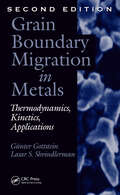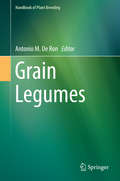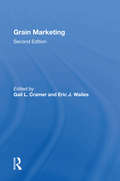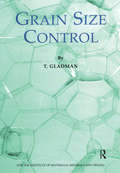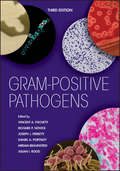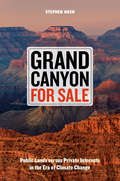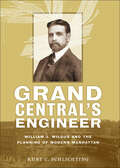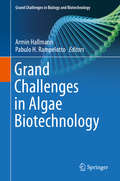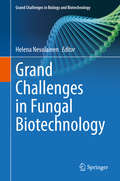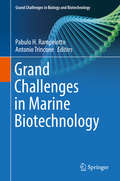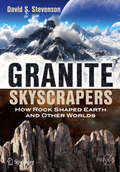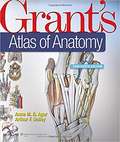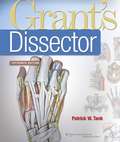- Table View
- List View
Grade 3 Science Resources
by Lawrence Hall of Science University of California at BerkeleyNIMAC-sourced textbook
Grade 4 Science Resources
by Lawrence Hall of Science University of California at BerkeleyNIMAC-sourced textbook
Grade 5 Science Resources
by Lawrence Hall of Science University of California at BerkeleyNIMAC-sourced textbook
Gradient Expectations: Structure, Origins, and Synthesis of Predictive Neural Networks
by Keith L. DowningAn insightful investigation into the mechanisms underlying the predictive functions of neural networks—and their ability to chart a new path for AI.Prediction is a cognitive advantage like few others, inherently linked to our ability to survive and thrive. Our brains are awash in signals that embody prediction. Can we extend this capability more explicitly into synthetic neural networks to improve the function of AI and enhance its place in our world? Gradient Expectations is a bold effort by Keith L. Downing to map the origins and anatomy of natural and artificial neural networks to explore how, when designed as predictive modules, their components might serve as the basis for the simulated evolution of advanced neural network systems.Downing delves into the known neural architecture of the mammalian brain to illuminate the structure of predictive networks and determine more precisely how the ability to predict might have evolved from more primitive neural circuits. He then surveys past and present computational neural models that leverage predictive mechanisms with biological plausibility, identifying elements, such as gradients, that natural and artificial networks share. Behind well-founded predictions lie gradients, Downing finds, but of a different scope than those that belong to today&’s deep learning. Digging into the connections between predictions and gradients, and their manifestation in the brain and neural networks, is one compelling example of how Downing enriches both our understanding of such relationships and their role in strengthening AI tools. Synthesizing critical research in neuroscience, cognitive science, and connectionism, Gradient Expectations offers unique depth and breadth of perspective on predictive neural-network models, including a grasp of predictive neural circuits that enables the integration of computational models of prediction with evolutionary algorithms.
Gradient HPLC for Practitioners: RP, LC-MS, Ion Analytics, Biochromatography, SFC, HILIC
by Stavros KromidasGradient Microstructure in Laser Shock Peened Materials: Fundamentals and Applications (Springer Series in Materials Science #314)
by Liucheng Zhou Weifeng HeThis book introduces the fundamentals and principles of laser shock peening (LSP) for aeronautical materials. It focuses on the innovation in both theory and method related to LSP-induced gradient structures in titanium alloys and Ni-based alloys which have been commonly used in aircraft industries. The main contents of the book include: the characteristics of laser shock wave, the formation mechanism of gradient structures and the strengthening-toughing mechanism by gradient structures. The research has accumulated a large amount of experimental data, which has proven the significant effectiveness of LSP on the improvement of the fatigue performance of metal parts, and related findings have been successfully applied in aerospace field. This book could be used by the researchers who work in the field of LSP, mechanical strength, machine manufacturing and surface engineering, as well as who major in laser shock wave and materials science.
Graduate Programs in Engineering & Applied Sciences 2011
by Peterson'S PublicationsPeterson's Graduate Programs in Engineering & Applied Sciences contains a wealth of information on colleges and universities that offer graduate degrees in the fields of Aerospace/Aeronautical Engineering; Agricultural Engineering & Bioengineering; Architectural Engineering, Biomedical Engineering & Biotechnology; Chemical Engineering; Civil & Environmental Engineering; Computer Science & Information Technology; Electrical & Computer Engineering; Energy & Power engineering; Engineering Design; Engineering Physics; Geological, Mineral/Mining, and Petroleum Engineering; Industrial Engineering; Management of Engineering & Technology; Materials Sciences & Engineering; Mechanical Engineering & Mechanics; Ocean Engineering; Paper & Textile Engineering; and Telecommunications. <P><P> Up-to-date data, collected through Peterson's Annual Survey of Graduate and Professional Institutions, provides valuable information on degree offerings, professional accreditation, jointly offered degrees, part-time and evening/weekend programs, post-baccalaureate distance degrees, faculty, students, degree requirements, entrance requirements, expenses, financial support, faculty research, and unit head and application contact information. <P> As an added bonus, readers will find a helpful "See Close-Up" link to in-depth program descriptions written by some of these institutions. These Close-Ups offer detailed information about the specific program or department, faculty members and their research, and links to the program Web site.<P> In addition, there are valuable articles on financial assistance and support at the graduate level and the graduate admissions process, with special advice for international and minority students. Another article discusses important facts about accreditation and provides a current list of accrediting agencies.
Graduate Programs in Engineering & Applied Sciences 2013
by Peterson'S PublicationsPeterson's Graduate Programs in Engineering & Applied Sciences 2013 contains comprehensive profiles of more than 3,850 graduate programs in 77 disciplines, including aerospace/aeronautical engineering, agricultural engineering & bioengineering, chemical engineering, civil and environmental engineering, computer science and information technology, electrical and computer engineering, industrial engineering, telecommunications, and more. <P><P> Up-to-date data, collected through Peterson's Annual Survey of Graduate and Professional Institutions, provides valuable information on degree offerings, professional accreditation, jointly offered degrees, part-time and evening/weekend programs, post-baccalaureate distance degrees, faculty, students, requirements, expenses, financial support, faculty research, and unit head and application contact information. <P>Two-page in-depth descriptions provide information about specific graduate programs, schools, or departments, faculty members and their research, and more.<P> There are also valuable articles on financial assistance, the graduate admissions process, advice for international and minority students, and facts about accreditation, with a current list of accrediting agencies.
Graft-Versus-Host Disease: Methods and Protocols (Methods in Molecular Biology #2907)
by Ronald SluyterThis book seeks to provide an overview of traditional and emerging protocols used to examine the aetiology, mechanisms and pathophysiology of GVHD, as well as those used to identify novel biomarkers and to test existing and new therapies to prevent or treat GVHD. Written in the format of the highly successful Methods in Molecular Biology series, each chapter includes an introduction to the topic, lists necessary materials and reagents, includes tips on troubleshooting and known pitfalls, and step-by-step, readily reproducible protocols. Authoritative and cutting-edge, Graft-Versus-Host Disease: Methods and Protocols aims to serve as a useful resource for current and future researchers in these and other areas of health and disease.
Grain Boundaries
by Louisette PriesterGrain boundaries are a main feature of crystalline materials. They play a key role in determining the properties of materials, especially when grain size decreases and even more so with the current improvements of processing tools and methods that allow us to control various elements in a polycrystal. This book presents the theoretical basis of the study of grain boundaries and aims to open up new lines of research in this area. The treatment is light on mathematical approaches while emphasizing practical examples; the issues they raise are discussed with reference to theories. The general approach of the book has two main goals: to lead the reader from the concept of 'ideal' to 'real' grain boundaries; to depart from established knowledge and address the opportunities emerging through "grain boundary engineering", the control of morphological and crystallographic features that affect material properties. The book is divided in three parts: I 'From interganular order to disorder' deals with the concept of the perfect grain boundary, at equilibrium, and questions the maintenance of its crystalline state. II 'From the ideal to the real grain boundary' deals with the concept of the faulted grain boundary. It attempts to reveal the influence of the grain boundary structure on its defects, their formation and their accommodation. III 'From free to constrained grain boundaries' is devoted to grain boundary ensembles starting from the triple junction (the elemental configuration) to real grain boundary networks in polycrystals This part covers a new and topical development in the field. It presents for the first time an avenue for researchers working on macroscopic aspects, to approach the scale of description of grain boundaries. Audience: graduate students, researchers and engineers in Materials Science and all those scientists pursuing grain boundary engineering in order to improve materials performance.
Grain Boundary Migration in Metals: Thermodynamics, Kinetics, Applications, Second Edition (Materials Science & Technology)
by Gunter Gottstein Lasar S. ShvindlermanA major goal of materials science is to create new engineering materials and optimize their cost and performance. Understanding how adjacent materials behave at their borders is an essential part of this process. Grain boundaries are the longest-known crystal defects, but although they were discovered in the mid-eighteenth century, until quite rece
Grain Legumes
by Antonio M. De RonThis book is devoted to grain legumes and include eight chapters devoted to the breeding of specific grain legume crops and five general chapters dealing with important topics which are common to most of the species in focus. Soybean is not included in the book as it is commonly considered an oil crop more than a grain legume and is included in the Oil Crops Volume of the Handbook of Plant Breeding. Legume species belong to the Fabaceae family and are characterized by their fruit, usually called pod. Several species of this family were domesticated by humans, such as soybean, common bean, faba bean, pea, chickpea, lentil, peanut, or cowpea. Some of these species are of great relevance as human and animal food. Food legumes are consumed either by their immature pod or their dry seeds, which have a high protein content. Globally, grain legumes are the most relevant source of plant protein, especially in many countries of Africa and Latin America, but there are some constraints in their production, such as a poor adaptation, pest and diseases and unstable yield. Current research trends in Legumes are focused on new methodologies involving genetic and omic studies, as well as new approaches to the genetic improvement of these species, including the relationships with their symbiotic rhizobia.
Grain Marketing: Second Edition
by Gail L CramerGrain Marketing explores the basic principles and concepts of grain marketing and analyzes the futures and options markets, agricultural policy, grain pricing, and grain marketing structures in the United States, Canada, and the European Community. This text helps students understand the world grain system, trains them to use futures and options, and explains how grain is marketed locally and internationally. The world grain industry affects our daily lives in ways both large and small. It influences what we consume for breakfast, lunch, and dinner and provides at least 40 percent of the world’s food supply. The U.S. and world grain industry affects our income, our investments, and global politics. As world population and therefore global demand for grain grows, the volume handled by the U.S. grain industry will continue to expand, demanding not only improvement in crop yields but also continued efforts to compete in increasingly sophisticated international markets. This newly revised, fully updated text provides a practical, comprehensive overview of grain marketing that is useful to both the upper-level undergraduate studying agricultural marketing and the professional working in the industry. Grain Marketing blends several approaches to the study of commodity marketing, combining the institutional, functional, market structure, and analytical and behavioral systems approach to grain marketing. The book includes basic background information for newcomers to the subject of agricultural marketing as well as more rigorous treatment of advanced subjects. The books overall plan allows the student to follow the movement of the major grains, corn, wheat, and soybeans from farm production to final consumption. Along the way, it provides a detailed description of the worldwide system, encompassing local and multinational corporations, state agencies and boards, national trade and agricultural policies, and the cash and futures markets that serve this industry.
Grain Size Control
by T. GladmanGrain Size Control provides an excellent account of the understanding of many matters concerning grains, grain structure, and grain growth in controlling the grain size of polycrystalline metals. It considers the application of the principles of grain growth.
Gram-Positive Pathogens (ASM Books #29)
by Miriam Braunstein Vincent Fischetti Richard Novick Joseph Ferretti Daniel Portnoy Julian RoodGram-positive bacteria, lacking an outer membrane and related secretory systems and having a thick peptidoglycan, have developed novel approaches to pathogenesis by acquiring (among others) a unique family of surface proteins, toxins, enzymes, and prophages. For the new edition, the editors have enhanced this fully researched compendium of Gram-positive bacterial pathogens by including new data generated using genomic sequencing as well as the latest knowledge on Gram-positive structure and mechanisms of antibiotic resistance and theories on the mechanisms of Gram-positive bacterial pathogenicity. This edition emphasizes streptococci, staphylococci, listeria, and spore-forming pathogens, with chapters written by many of the leading researchers in these areas. The chapters systematically dissect these organisms biologically, genetically, and immunologically, in an attempt to understand the strategies used by these bacteria to cause human disease. “This textbook comprises a superb collection of scientific knowledge making it a must-read for any graduate student, medical doctor, or investigator studying these gram-positive bacteria and inspiring future imaginations of biological knowledge.” - William R. Jacobs, Jr., PhD, Professor Microbiology & Immunology, Albert Einstein College of Medicine
Grand Canyon For Sale: Public Lands versus Private Interests in the Era of Climate Change
by Stephen NashGrand Canyon For Sale is a carefully researched investigation of the precarious future of America’s public lands: our national parks, forests, wildlife refuges, monuments, and wildernesses. Taking the Grand Canyon as his key example, and using on-the-ground reporting as well as scientific research, Stephen Nash shows how accelerating climate change will dislocate wildlife populations and vegetation across hundreds of thousands of square miles of the national landscape. In addition, a growing political movement, well financed and occasionally violent, is fighting to break up these federal lands and return them to state, local, and private control. That scheme would foreclose the future for many wild species, which are part of our irreplaceable natural heritage, and also would devastate our national parks, forests, and other public lands. To safeguard wildlife and their habitats, it is essential to consolidate protected areas and prioritize natural systems over mining, grazing, drilling, and logging. Grand Canyon For Sale provides an excellent overview of the physical and biological challenges facing public lands. The book also exposes and shows how to combat the political activity that threatens these places in the U.S. today.
Grand Central's Engineer: William J. Wilgus and the Planning of Modern Manhattan (The Johns Hopkins University Studies in Historical and Political Science #130)
by Kurt C. SchlichtingFew people have had as profound an impact on the history of New York City as William J. Wilgus. As chief engineer of the New York Central Railroad, Wilgus conceived the Grand Central Terminal, the city’s magnificent monument to America’s Railway Age. Kurt C. Schlichting here examines the remarkable career of this innovator, revealing how his tireless work moving people and goods over and under Manhattan Island’s surrounding waterways forever changed New York’s bustling transportation system.After his herculean efforts on behalf of Grand Central, the most complicated construction project in New York’s history, Wilgus turned to solving the city’s transportation quandary: Manhattan—the financial, commercial, and cultural hub of the United States in the twentieth century—was separated from the mainland by two major rivers to the west and east, a deep-water estuary to the south, and the Harlem River to the north.Wilgus believed that railroads and mass transportation provided the answer to New York City’s complicated geography. His ingenious ideas included a freight subway linking rail facilities in New Jersey with manufacturers and shippers in Manhattan, a freight and passenger tunnel connecting Staten Island and Brooklyn, and a belt railway interconnecting sixteen private railroads serving the metropolitan area. Schlichting’s deep passion for Wilgus and his engineering achievements are evident in the pages of this fascinating work. Wilgus was a true pioneer, and Schlichting ensures that his brilliant contributions to New York City’s transportation system will not be forgotten.Praise for Schlichting's Grand Central Terminal"Grand Central Terminal is celebrated for its Beaux-Arts style, but Kurt C. Schlichting looks behind the facade to see the hidden engineering marvels."—New York Times Book Review"His study peels away our contemporary expectations and experiences and reveals the layers of history and acts of men that served as the foundation for this great structure."—H-Urban, H-Net Review"The most detailed account yet of one of the most important events in the history of 20th-century architecture, railroad development, and city building."—Choice"In his detailed accounts of the fiscal, stylistic, and engineering decisions that went into the creation of... Grand Central Terminal, Schlichting clearly shows both how energetic and talented all of the people involved were and how dramatically they altered this central portion of New York City."—Journal of the Society of Architectural Historians"Ably tells the story of the New York rail system's most active and visible symbol: the architectural and engineering masterpiece, with its grand public concourse, in the heart of Midtown."—New Scientist
Grand Challenges in Algae Biotechnology (Grand Challenges in Biology and Biotechnology)
by Pabulo H. Rampelotto Armin HallmannIn this book, researchers and practitioners working in the field present the major promises of algae biotechnology and they critically discuss the challenges arising from applications. Based on this assessment, the authors explore the great scientific, industrial and economic potential opened up by algae biotechnology. The first part of the book presents recent developments in key enabling technologies, which are the driving force to unleash the enormous potential of algae biotechnology. The second part of the book focuses on how practical applications of algae biotechnology may provide new solutions to some of the grand challenges of the 21st century.Algae offer great potential to support the building of a bio-based economy and they can contribute new solutions to some of the grand challenges of the 21st century. Despite significant progress, algae biotechnology is yet far from fulfilling its potential. How to unleash this enormous potential is the challenge that the own field is facing. New cultivation technologies and bioprocess engineering allow for optimization of the operation strategy of state-of the art industrial-scale production systems and they reduce the production costs. Parallel to this, new molecular technologies for genetic and metabolic engineering of (micro)algae develop quickly. The optimization of existing biochemical pathways or the introduction of pathway components makes high-yield production of specific metabolites possible. Novel screening technologies including high-throughput technologies enables testing of extremely large numbers of samples and, thus, allow for large scale modelling of biomolecular processes, which would have not been possible in the past. Moreover, profitable production can demand for integrated biorefining, which combines consecutive processes and various feedstocks to produce both transportation fuel, electric energy and valuable chemicals.
Grand Challenges in Fungal Biotechnology (Grand Challenges in Biology and Biotechnology)
by Helena NevalainenThis volume provides a comprehensive overview of the major applications and potential of fungal biotechnology. The respective chapters report on the latest advances and opportunities in each topic area, proposing new and sustainable solutions to some of the major challenges faced by modern society. Aimed at researchers and biotechnologists in academia and industry, it represents essential reading for anyone interested in fungal biotechnology, as well as those working within the broader area of microbial biotechnology. Written in an accessible language, the book also offers a valuable reference resource for decision-makers in government and at non-governmental organizations who are involved in the development of cleaner technologies and the global bioeconomy. The 21st century is characterized by a number of critical challenges in terms of human health, developing a sustainable bioeconomy, facilitating agricultural production, and establishing practices that support a cleaner environment. While there are chemical solutions to some of these challenges, developing bio-based approaches is becoming increasingly important. Filamentous fungi, ‘the forgotten kingdom,’ are a group of unique organisms whose full potential has yet to be revealed. Some key properties, such as their exceptional capacity to secrete proteins into the external environment, have already been successfully harnessed for the production of industrial enzymes and cellulosic biofuels. Many further aspects discussed here –such as feeding the hungry with fungal protein, and the potential applications of the various small molecules produced by fungi –warrant further exploration. In turn, the book covers the use of fungal cell factories to produce foreign molecules, e.g. for therapeutics. Strategies including molecular approaches to strain improvement, and recent advances in high-throughput technologies, which are key to finding better products and producers, are also addressed. Lastly, the book discusses the advent of synthetic biology, which is destined to greatly expand the scope of fungal biotechnology. The chapter “Fungal Biotechnology in Space: Why and How?” is available open access under a Creative Commons Attribution 4.0 International License at link.springer.com.
Grand Challenges in Marine Biotechnology (Grand Challenges In Biology And Biotechnology Ser.)
by Pabulo H. Rampelotto Antonio TrinconeThis book serves as essential reading for research scientists and biotechnologists from both academia and industry working in marine biotechnology and related disciplines. The book discusses recent advances and challenges in terms of science, technology, innovation, and policy for the development of the field; and how marine biotechnology may provide new solutions to some of the grand challenges faced by our society. Written in an accessible language, the book is also recommended as a reference text for decision-makers in government and non-governmental organizations in their efforts to foster the development of a global blue economy. With less than 5 % of the vast and rich marine environment explored, our seas and oceans represent a virtually unexplored resource for the discovery of novel product, processes, and development of bio-inspired synthetic drugs with biotechnological potential. As such, the marine environment has been considered Earth's last frontier of exploration. Recent advances in molecular techniques are providing the necessary tools to access on a larger scale the still-untapped ocean resources and, consequently, unveil the promise of the blue biotechnology. Governments are recognizing the potential of marine biotechnology to provide solutions to some of the Grand Challenges of the 21st Century such as sustainable energy and food sources, identification of novel drugs for improved health treatments, and providing new industrial materials and processes. For this reason, advances in marine biotechnology may foster the much-needed source of innovation and economic growth in many countries, and pave the way towards the development of a global blue economy, i.e. a new economic model based on the sustainable exploration of our ocean ecosystems.
Grand Ethiopian Renaissance Dam Versus Aswan High Dam: A View from Egypt (The Handbook of Environmental Chemistry #79)
by Abdelazim M. Negm Sommer Abdel-FattahThis unique volume discusses various aspects of the Grand Ethiopian Renaissance Dam (GERD) and the Aswan High Dam (AHD) including their positive and negative impacts. It presents up-to-date research findings by Egyptian scientists and researchers covering several interesting hot topics under the following main themes: · Major impacts of GERD compared with the AHD · Environmental impacts of the AHD · Modeling scenarios investigating the impacts of GERD on the AHD and downstream · Environmental and social impacts of GERD on Egypt · Status and assessment of the sediment of the AHD reservoir and modeling the impacts of GERD on Lake Nubia sediment accumulation · Proposed scenarios for maximizing the benefits of the AHD reservoir · International aspects of GERD and the AHD The volume also offers a set of conclusions and recommendations to optimize the cooperation between Egypt, Sudan, and Ethiopia. It appeals to postgraduate students, researchers, scientists, professionals and policy planners.
Granite Skyscrapers: How Rock Shaped Earth and Other Worlds (Springer Praxis Books)
by David S. StevensonIn this book, David Stevenson offers us a look at the evolution of planets as they move from balls of mixed molten rock to vibrant worlds capable of hosting life. Embedded in our everyday architecture and in the literal ground beneath our feet, granite and its kin lie at the heart of many features of the Earth that we take for granted. From volcanism and mountain building to shifting water levels and local weather patterns, these rocks are closely intertwined with the complex processes that continue to shape and reshape our world. This book serves as a wonderful primer for anybody interested in our planet’s geological past and that of other planets in our Solar System and beyond. It illustrates not only how our planet’s surface evolved, but also how granite played a pivotal role in the creation of complex, intelligent life on Earth. There has long been a missing element in popular astronomy, which Stevenson now aims to fill: how geological and biological evolution work in a complex partnership, and what our planet’s own diversity can teach us about other rocky worlds.
Grant's Atlas of Anatomy
by Anne M. R. Agur Arthur F. DalleyA cornerstone of gross anatomy since 1943, Grant's Atlas of Anatomy reaches students worldwide with its realistic dissection illustrations, detailed surface anatomy photos, clinical images and comments, and quick-reference muscle tables. Renowned for its accuracy, pedagogy, and clinical relevance, this classic atlas boasts significant enhancements, including updated artwork, new conceptual diagrams, and vibrantly re-colored illustrations. Clinical material is clearly highlighted in blue text for easy identification.
Grant's Dissector
by Patrick W. TankGrant's Dissector walks students step by step through dissection procedures in the anatomy lab. Each chapter is consistently organized beginning with a brief study of surface anatomy followed by concise coverage of osteology, presenting important foundational structures that will aid in localization of soft tissue structures. Each dissection unit begins with a "Dissection Overview" providing a guide of what is to be accomplished during the dissection session. This is followed by "Dissection Instructions," with a logical sequence and numbered steps for the dissection. Each dissection concludes with a "Dissection Review" that presents a numbered lists of tasks illustrating the important features of the dissection and encouraging the synthesis of information.

